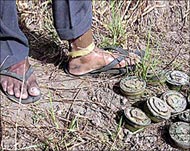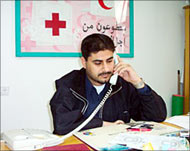Landmines: Palestine’s hidden danger
All over Gaza, large well-illustrated billboards sporting the UNICEF logo can be seen alongside major streets and busy intersections.

They show photos of Israeli-made bombs and mines and carry a single in-your-face message: “Landmines and suspicious objects are a danger that threatens us all! Do not try to get near them!”
While landmines usually invoke images of places like once war-torn Angola or Afghanistan, the issue is gaining increasing prominence in the occupied Palestinian territories.
UNICEF representatives say the occupied West Bank and Gaza are littered with landmines dating back to the 1967 invasion.
Most of the declared minefields lie on the Jordanian-West Bank border, as well as in the Jordan Valley-areas that Israel considers strategic lines of defence.
No minefields have been officially declared in the Gaza Strip, but Ayid Abu Qtaish, mine awareness coordinator of Defence for Children International, Palestine Section (DCI), has no doubt the overpopulated strip of land is chock-full of them.
“If there are minefields on the border between Jordan and the West Bank as a defensive measure, by extension there must be landmines between Egypt and Gaza, and throughout the Gaza Strip.”
Increasing danger
Landmines were not considered a serious threat in the West Bank and Gaza until recently, when medical personnel and aid workers began to notice a sudden upsurge in mine and unexploded ordnance (UXO) fatalities and causalities.
 |
|
Use of landmines as a weapon |
At least 23 children have been killed by landmines or UXO planted by the Israeli military in the occupied Palestinian territories since the start of the Intifada in September 2000.
In 2002, DCI documented 57 landmine and UXO casualties, including 13 deaths, 11 of them children; 31 of these casualties occurred in the period during and following Israeli military operations in the Jenin refugee camp in April 2002.
A UNICEF assessment of the landmine and UXO situation concluded that most affected areas are not properly marked, or not marked at all. This includes Israeli military training zones, many of which are located near populated urban areas.
The problem, however, extends beyond such military zones and declared sites according to UNICEF spokesperson Monica Awad.
“[It] reaches areas of confrontation between Palestinians and Israeli soldiers, where many exploding objects are left behind. Areas of confrontation like Jenin are left littered with Israeli and Palestinian unexploded ordnance and improvised explosive devices.”
In March of 2002, a Palestinian woman and four children died in an explosion near the Gaza refugee camp of al-Buraij when the donkey cart they were riding on detonated a landmine left behind by withdrawing Israeli occupation forces.
In the West Bank, local residents on both the Dair Abu Dayyaf checkpoint and the Zurdah checkpoint in al-Birah have discovered several mines. Hundreds of Palestinian commuters on a daily basis use both crossings.
Innocent victims
Children are the most common victims of landmine and UXO blasts. They are often not aware of the dangers of landmines and UXOs and are usually killed as a result of getting close to or playing with the suspicious objects or landmines.
 |
|
Mahmud al-Kurdi of the Palestine |
According to the DCI, the suspicious objects are often unexploded shells and bombs fired by the Israeli forces.
Early last year in the Gaza Strip, five Palestinian children were killed when they stepped on a booby-trapped landmine. They were on their way to school in the Khan Yunis refugee camp.
|
|
Israeli officials said the booby trap was intended to prevent Palestinians from infiltrating into a neighbouring Jewish settlement.
“The problem has escalated, now it’s not only in military zones but in all Palestinian areas. We never imagined in Ram Allah there would be an explosion of unexploded munitions,” said Abu Qtaish.
He was referring to an incident near Bir al-Jadida school in Ram Allah, where three children were killed and five others injured after stepping on a UXO.
Landmine Ban
The use of landmines as a weapon has been discouraged globally because of the indiscriminate nature of the way they operate.
According to the International Committee to Ban Landmines (ICBL), “antipersonnel mines cannot distinguish between the footfall of a soldier and that of a child. They recognize no cease-fire and long after the fighting has stopped they continue to maim or kill.”
|
“The best choice for us in Palestinian is awareness since there are Israeli restrictions on removal of landmines” |
Israel has abstained from voting on every annual pro-landmine ban UN General Assembly resolution since 1996.
It has not acceded to the Mine Ban Treaty, which prohibits not only antipersonnel mines, but also explosive booby-traps and other improvised explosive devices (IED) that are victim activated.
Israeli Foreign Ministry officials say the state is not in a position to separate its landmine policy from other regional security considerations.
However, many, like Abu Qtaish, are not convinced.
“The landmines they have planted have absolutely no military or security necessity… its for safety not security reasons that they keep them there-most of them are old and their removal is dangerous,” he said.
Obstacles
Three different methods are commonly employed to deal with the landmine problem worldwide, including clearance, survival assistance and risk-education. Usually, a combination of all three methods is used to combat the problem.
 |
|
A UAE-funded landmine clearing |
In Palestine, however, the political situation renders all but one impractical.
“The best choice for us in Palestinian is awareness since there are Israeli restrictions on removal of landmines,” said Abu Qtaish.
A Canadian initiative to de-mine the village of Husan near Bethlehem, for example, was stopped short due to an Israeli ban on the import of mine-cleaning materials and restrictions on the method of clearing.
In February 2003, Israel commented for the first time on the scope of this stockpile destruction effort, saying 12 tonnes of mines were destroyed by the military in 2002.
Abu Qtaish says this, however, is not enough.
“Practically speaking there has been no mine clearing. [T]here is a big difference between clearing minefields for military purposes and clearing them for humanitarian purposes. In the latter case, the number of mines must be zero,” he said.
According to Abu Qtaish, the Israeli military declared the village of Husan in the West Bank a mine-free zone early last year. Following the announcement, three people from the village died when a mine exploded under them, prompting DCI and others to pursue the de-mining endeavour.
Awareness campaign
In August 2002, a National Mine Action Committee was created consisting of UNICEF, UNRWA, the Palestinian Red Crescent Society, Defence for Children International in Palestine, and the Palestinian Ministries of Education, Youth and Sports, Interior, and Health.
|
Some 1 million Palestinian children have been educated on landmine awareness. |
In the absence of other alternatives, such as speaking with Israeli forces about de-mining areas of land near civilian populations, the organisations are doing what they can to make sure the problem does not get out of hand.
Mainly they are educating the population on the risks of mines. Their target population has been children.
UNICEF says so far, the initiative has been successful – the children are responding well and beginning to understand the dangers involved in playing with UXO and landmines.
“We were able to reach at least one million Palestinian children with key messages on UXO/landmine prevention,” said Awad.
“We need to find alternatives for kids,” added Mahmud al-Kurdi of the Palestinian Red Crescent Society in Gaza.
“Right now they are playing in the streets, they see something that looks interesting to play with, they pick it up, or prod at it, and throw stones at it, and it explodes.”
“It’s not just a matter of putting posters up on the streets.”